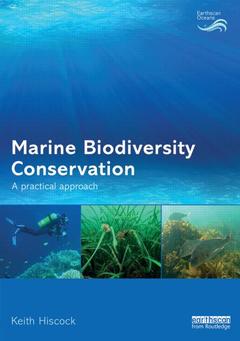Description
Marine Biodiversity Conservation
A Practical Approach
Earthscan Oceans Series
Author: Hiscock Keith
Language: English
Subjects for Marine Biodiversity Conservation:
Keywords
marine ecology; benthos; Spiny Lobsters; marine protected areas; UK Water; Marine Strategy Framework Directive; Marine Biodiversity Conservation; Cliona Celata; IUCN Red List; Articial Reefs; Scallop Dredging; Kelp Forests; Harmful Algal Blooms; Zostera Marina; European Union Marine Strategy Framework; EU Habitat Directive; MSP; Cetorhinus Maximus; MLPA; Biotic Index; Phymatolithon Calcareum; Vessel Monitoring Systems; South West England; EcIA; Great Barrier Reef Marine Park; Seagrass Beds; Scuba Diving
Publication date: 08-2014
Support: Print on demand
Publication date: 08-2014
320 p. · 17.4x24.6 cm · Hardback
Description
/li>Contents
/li>Readership
/li>Biography
/li>
Effective marine biodiversity conservation is dependent upon a clear scientific rationale for practical interventions. This book is intended to provide knowledge and tools for marine conservation practitioners and to identify issues and mechanisms for upper-level undergraduate and Masters students. It also provides sound guidance for marine biology field course work and professionals.
The main focus is on benthic species living on or in the seabed and immediately above, rather than on commercial fisheries or highly mobile vertebrates. Such species, including algae and invertebrates, are fundamental to a stable and sustainable marine ecosystem. The book is a practical guide based on a clear exposition of the principles of marine ecology and species biology to demonstrate how marine conservation issues and mechanisms have been tackled worldwide and especially the criteria, structures and decision trees that practitioners and managers will find useful. Well illustrated with conceptual diagrams and flow charts, the book includes case study examples from both temperate and tropical marine environments.
1. The Need for Marine Biodiversity Conservation 2. What is Where and How Much of It is There? The Role of Science 3. Ecosystem Structure, Functioning and Viability 4. Understanding Change 5. Impacts of Human Activities on Ecosystem Composition, Structure and Function 6. The Application of Science to Management: Introduction 7. ‘Threatened’ and ‘Sensitive’ Species and Habitats 8. Sampling and Recording 9. Selection, Design and Management of Marine Protected Areas 10. Assessing Likely Impacts and Monitoring Change 11. Recovery, Restoration and Replacement of Habitats and Species 12. Conclusions and the Manager’s ‘Toolbox’




